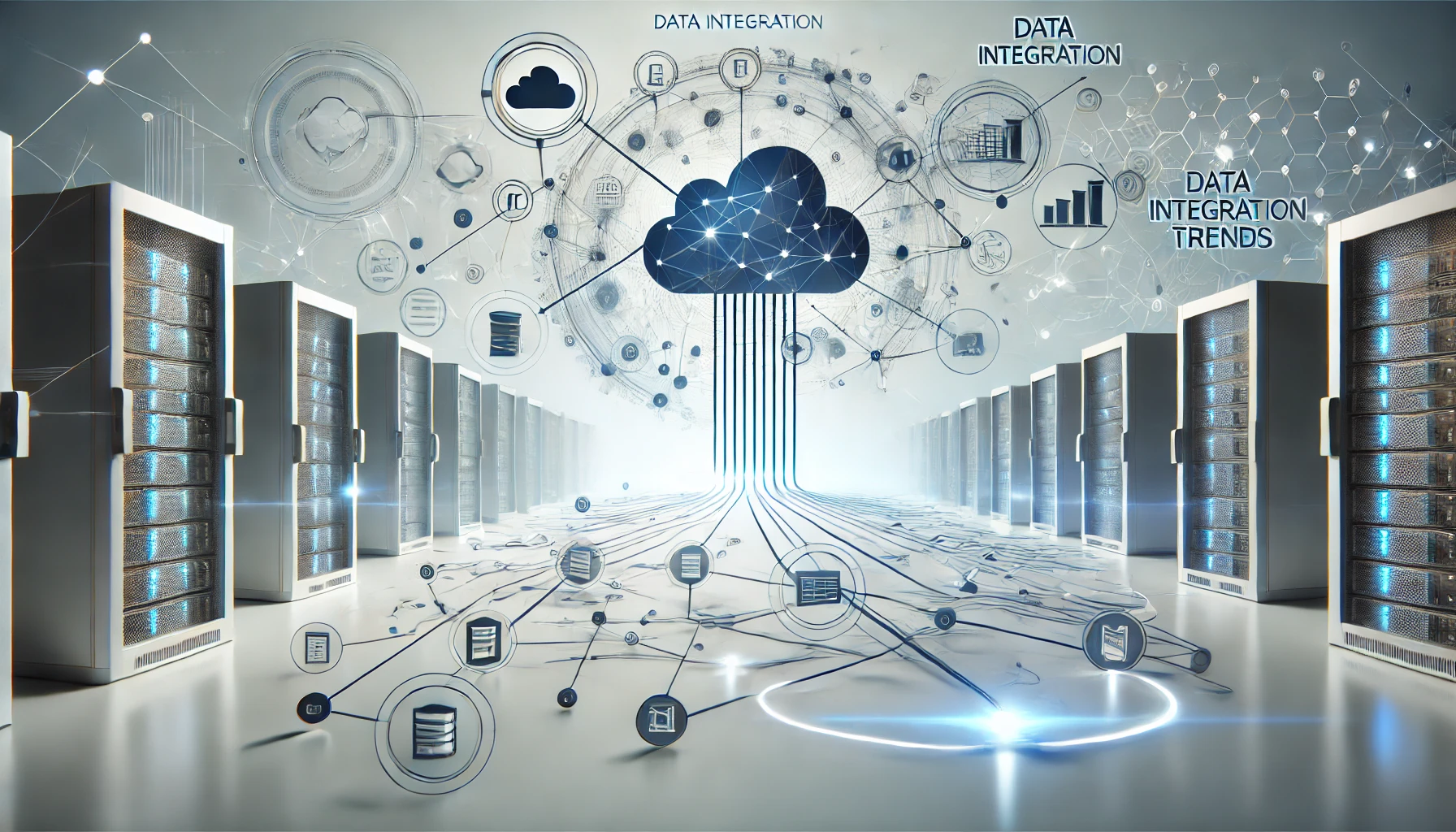As you navigate the evolving landscape of data integration, staying informed about the top trends can be crucial for your organization’s strategic planning. From cloud-based solutions to real-time capabilities and AI-driven insights, the upcoming years hold significant transformations in how data is managed and leveraged. Understanding these trends can provide you with a competitive edge and ensure your data integration strategies remain relevant and effective in the face of rapid technological advancements.
Cloud-based Integration
In the realm of data integration trends, cloud-based integration stands out as a pivotal advancement. Cloud-based integration offers a scalable infrastructure that allows organizations to expand their data processing capabilities effortlessly. This flexibility is crucial in today’s fast-paced digital landscape where data volumes are constantly increasing. By leveraging cloud-based integration, companies can easily adjust their data processing capabilities to meet changing demands without the need for significant upfront investments in hardware.
One of the key features of cloud-based integration is data encryption. This security measure ensures that data transmitted between systems is protected from unauthorized access. With data encryption, organizations can confidently move sensitive information across different platforms without compromising data security. Additionally, cloud-based integration platforms often provide built-in encryption tools, making it easier for businesses to secure their data without extensive technical expertise.
Hybrid Integration
Amidst the evolving landscape of data integration trends, Hybrid Integration emerges as a strategic approach that combines the strengths of on-premise and cloud-based systems. Organizations face various data integration challenges, including the need to seamlessly connect disparate systems, handle large volumes of data, and ensure data security and compliance. Hybrid integration strategies offer a solution by allowing businesses to leverage the scalability and flexibility of cloud platforms while maintaining control over sensitive data stored on-premise.
One of the key advantages of hybrid integration is its ability to bridge the gap between on-premise and cloud environments, enabling seamless data flow between different systems. By implementing a hybrid integration approach, companies can optimize their data integration processes, enhance operational efficiency, and achieve a more agile and responsive IT infrastructure. This strategy also provides the flexibility to scale resources up or down based on changing business needs, ensuring cost-effectiveness and adaptability in dynamic market conditions. In the coming years, hybrid integration is poised to play a crucial role in helping organizations overcome data integration challenges and drive digital transformation initiatives.
Data Lakes
Hybrid integration has paved the way for organizations to optimize their data integration processes and enhance operational efficiency. Data lakes, a central component of modern data architecture, offer a scalable solution for storing and processing vast amounts of structured and unstructured data. Data lake architecture involves a flat structure that allows for data to be stored in its raw format until needed, enabling flexibility and agility in data processing.
The benefits of data lakes are numerous. They provide a cost-effective storage solution, as they eliminate the need for data transformation before storage. Additionally, data lakes facilitate advanced analytics, machine learning, and other data-driven initiatives by allowing organizations to analyze large datasets in their original form. This preserves data integrity and enables more accurate insights. Moreover, data lakes support real-time data processing, enabling organizations to make informed decisions based on up-to-date information. Embracing data lake architecture can lead to improved data management, enhanced decision-making, and increased organizational agility.
Real-Time Integration
Real-Time Integration is becoming increasingly crucial in today’s fast-paced data environments. The speed of integration allows for immediate data updates across systems, ensuring that information is always current and accurate. Synchronized systems enable organizations to make real-time decisions based on the most up-to-date data available, ultimately improving operational efficiency and responsiveness.
Speed of Integration
Data integration has become increasingly crucial in today’s fast-paced digital landscape. When considering the speed of integration, two key factors come into play: integration efficiency and data latency. Integration efficiency refers to the ability to quickly and accurately combine data from various sources, ensuring that the process is streamlined and optimized for rapid integration. On the other hand, data latency pertains to the delay between data generation and its availability for integration. Minimizing data latency is essential for enabling real-time integration, where up-to-date information is crucial for making informed business decisions.
To enhance the speed of integration, organizations are investing in technologies such as real-time data processing and event-driven architectures. These solutions enable data to be processed and integrated as soon as it is generated, reducing latency and ensuring that insights are delivered in a timely manner. By prioritizing speed in data integration processes, businesses can stay agile and responsive in today’s competitive landscape.
Immediate Data Updates
Enhancing your data integration capabilities to enable immediate data updates is a strategic imperative in today’s fast-paced business environment. Real-time integration ensures that your data accuracy and data consistency are maintained at all times. By implementing immediate data updates, you can eliminate the risks associated with outdated information and make more informed decisions based on the most current data available.
One of the key benefits of immediate data updates is the ability to react swiftly to changes in your business environment. With real-time integration, any modifications made in one system are instantly reflected in all connected systems, ensuring data consistency across the board. This rapid synchronization enhances operational efficiency and reduces the chances of errors caused by discrepancies in information.
Moreover, real-time integration facilitates better decision-making by providing up-to-the-minute insights into your business processes. By ensuring data accuracy through immediate updates, you can trust that the information you are working with is always current and reliable. This level of accuracy and consistency in data empowers you to make more effective strategic choices that drive your business forward.
Synchronized Systems
Achieving synchronized systems through real-time integration is a critical aspect of modern data management strategies. Data synchronization challenges often arise due to the need to ensure that data across various systems remains consistent and up-to-date. One common challenge is dealing with conflicting data updates that occur simultaneously in different systems. To address this, synchronization best practices recommend implementing conflict resolution mechanisms that prioritize data accuracy and integrity.
Real-time integration plays a key role in synchronizing systems by enabling immediate data updates to be shared across platforms seamlessly. By leveraging technologies like Change Data Capture (CDC) and event-driven architecture, organizations can achieve near real-time synchronization of data, ensuring that all systems are working with the most current information available. These approaches not only help in maintaining data consistency but also enhance operational efficiency by enabling faster decision-making processes based on the latest data insights.
Artificial Intelligence and Machine Learning
Artificial Intelligence and Machine Learning have revolutionized the landscape of data integration, providing organizations with unprecedented capabilities to extract valuable insights from vast amounts of data. Leveraging AI integration strategies and ML data management can significantly enhance your data integration processes. Here are some key aspects to consider:
- Automated Data Mapping: AI algorithms can automatically map data sources, formats, and schemas, streamlining the integration process.
- Predictive Analytics: Machine Learning models can predict potential data integration issues and recommend solutions proactively.
- Real-time Data Processing: AI-powered systems enable real-time data processing, ensuring that insights are up-to-date and actionable.
- Anomaly Detection: Machine Learning algorithms can detect anomalies in integrated data sets, flagging potential errors or inconsistencies for further investigation.
Internet of Things
The Internet of Things (IoT) has significantly impacted data integration processes by introducing a multitude of endpoints and data sources that need to be seamlessly connected. This extensive network of interconnected devices has raised concerns regarding data security, prompting organizations to implement robust measures to safeguard sensitive information. Additionally, the real-time nature of IoT data necessitates agile integration solutions capable of processing and analyzing data instantaneously to derive valuable insights.
IoT Impact on Integration
The proliferation of Internet of Things (IoT) devices has significantly impacted data integration processes in various industries. With the sheer volume and diversity of IoT devices generating massive amounts of data, organizations face unique challenges in integrating this data effectively.
- Data Variety: IoT devices produce data in various formats, such as structured, unstructured, and semi-structured, making it complex to integrate into existing systems.
- Real-Time Processing: The need for real-time data processing from IoT devices requires integration solutions that can handle high-speed data ingestion and processing.
- Scalability: As the number of IoT devices grows, integration systems must be scalable to accommodate the increasing data flow without compromising performance.
- Interoperability: Ensuring seamless communication and data exchange between different IoT devices and systems poses integration challenges that need to be addressed for efficient data flow.
Successfully managing the IoT impact on integration involves implementing robust integration solutions capable of handling diverse data formats, real-time processing requirements, scalability, and interoperability challenges.
Data Security Concerns
Experiencing a surge in connectivity and data exchange, the Internet of Things (IoT) landscape presents a host of challenges, with data security emerging as a critical concern. To address this, robust data encryption methods must be implemented to safeguard sensitive information transmitted across IoT devices. Additionally, stringent data access controls should be established to regulate who can view and modify data within the IoT ecosystem, reducing the risk of unauthorized access.
Threat detection mechanisms play a pivotal role in identifying potential cybersecurity breaches in real-time. By continuously monitoring IoT networks for anomalies and suspicious activities, organizations can swiftly respond to security incidents, mitigating potential damages. Incident response protocols should be well-defined and regularly tested to ensure a rapid and effective response to security breaches.
Real-time Data Processing
Amid the rapid proliferation of connected devices in the Internet of Things (IoT) realm, real-time data processing has emerged as a critical operational requirement. This trend is driven by the need to analyze and act on data as soon as it is generated, enabling organizations to make faster and more informed decisions. In this landscape, stream processing and event-driven architecture play pivotal roles in facilitating real-time data processing. Here’s how these technologies are shaping the future of data integration:
- Stream Processing: Allows for the continuous processing of data records as they are generated, enabling real-time insights and actions.
- Event-Driven Architecture: Focuses on detecting and responding to events in real time, ensuring timely reactions to changing data conditions.
- Scalability: Real-time data processing systems need to be scalable to handle large volumes of data generated by IoT devices.
- Integration Challenges: Ensuring seamless integration of real-time data processing systems with existing IT infrastructure poses a significant challenge.
API-led Connectivity
During the rapid evolution of data integration trends, one key concept that has emerged as a game-changer is the strategy of API-led Connectivity. API governance ensures that APIs are managed effectively, addressing aspects like security, compliance, and version control. Scalability in API design is crucial for accommodating growing data volumes and user demands efficiently. By focusing on API performance, organizations can optimize data flow and processing speed, enhancing overall system efficiency.
API-led Connectivity fosters seamless interaction between diverse applications and systems by utilizing APIs as the primary means of communication. This approach enables businesses to connect different technologies, applications, and data sources in a modular and flexible manner. With well-designed APIs, organizations can streamline data integration processes, reduce development time, and enhance system interoperability. Embracing API-led Connectivity not only improves agility but also empowers businesses to adapt quickly to changing market demands and technological advancements.
Data Governance
When it comes to data governance, ensuring the proper management and control of data is crucial in today’s regulatory landscape. By implementing robust governance practices, organizations can not only mitigate risks but also demonstrate compliance with industry regulations and standards. Establishing clear regulatory compliance strategies is essential for maintaining data integrity and trustworthiness throughout the data integration process.
Importance of Governance
Data governance plays a pivotal role in the realm of data integration, ensuring that organizations maintain control and consistency over their data assets. To achieve effective data governance, organizations should consider implementing the following key practices:
- Governance Frameworks: Establishing robust governance frameworks helps define the organizational structure, roles, responsibilities, and processes related to data management. This ensures clear accountability and decision-making processes.
- Data Quality Controls: Implementing data quality controls is essential to maintain the accuracy, completeness, and reliability of data. By setting standards, performing regular data quality assessments, and implementing corrective measures, organizations can enhance the overall quality of their data assets.
- Data Stewardship: Assigning data stewards who are responsible for overseeing data assets, ensuring compliance with governance policies, and facilitating data-related decisions can greatly contribute to effective data governance.
- Metadata Management: Proper management of metadata, including data definitions, lineage, and usage, is critical for understanding and effectively utilizing data assets within an organization. Metadata management supports data governance by providing insights into data characteristics and usage across the organization.
Regulatory Compliance Strategies
To ensure regulatory compliance within the realm of data governance, organizations must strategically align their policies and practices with relevant laws and industry standards. Privacy regulations, such as GDPR and CCPA, require organizations to handle sensitive data in a secure and compliant manner. Compliance automation tools play a crucial role in simplifying the process of adhering to these regulations by automating data monitoring, access controls, and reporting.
Implementing robust data governance frameworks that incorporate compliance automation can help organizations streamline their regulatory compliance efforts. By centralizing data management processes and enforcing strict access controls, organizations can ensure that sensitive information is handled in accordance with privacy regulations. Regular audits and assessments are essential to monitor compliance levels and identify any potential gaps that need to be addressed promptly.
Self-service Integration
With the increasing complexity of data environments and the growing demand for agility in decision-making processes, self-service integration has emerged as a critical solution for organizations seeking to streamline data integration tasks. This approach empowers users to take control of integrating data from various sources efficiently. Here are some key aspects of self-service integration:
- User Empowerment: Self-service integration puts the power in the hands of users, allowing them to manipulate and integrate data without heavy reliance on IT departments.
- Simplified Processes: By providing user-friendly tools and interfaces, self-service integration simplifies the data integration process, making it more accessible to a wider range of users.
- Increased Efficiency: Users can quickly combine data from different sources, saving time and reducing bottlenecks in the integration process.
- Flexibility: Self-service integration tools offer flexibility in choosing data sources and formats, enabling users to adapt to changing business needs rapidly.
Self-service integration not only enhances agility but also fosters a culture of data-driven decision-making within organizations.
Big Data Analytics
Amidst the ever-expanding landscape of data utilization, Big Data Analytics stands as a cornerstone for organizations striving to extract valuable insights from vast and varied datasets. By leveraging predictive modeling, organizations can anticipate future trends and behaviors based on historical data patterns. This forward-looking approach empowers decision-makers to proactively address challenges and seize opportunities.
Big Data Analytics enables trend analysis by scrutinizing large volumes of data to identify patterns, correlations, and anomalies. Through advanced algorithms and machine learning techniques, organizations can uncover hidden insights that drive strategic decision-making. By understanding trends and patterns, businesses can make informed decisions, optimize processes, and gain a competitive edge in the market.
Frequently Asked Questions
How Can Data Integration Improve Customer Experience?
You can enhance customer experience through data integration by leveraging personalization to tailor interactions and automation to streamline processes. By integrating data effectively, you can offer targeted services, anticipate needs, and provide seamless experiences.
What Are the Best Practices for Data Quality Management?
To maintain high data quality, start with data profiling to understand its structure and content. Implement data cleansing to correct errors and inconsistencies. Regularly monitor and update data quality processes to ensure accurate and reliable information.
Is Data Integration Secure From Cyber Threats?
Data encryption is essential for securing data integration from cyber threats. Implement robust access controls to prevent unauthorized access. Regularly update encryption protocols and access policies to stay ahead of evolving threats. Stay vigilant to protect sensitive data from potential breaches.
How Does Data Integration Impact Regulatory Compliance?
Data integration plays a crucial role in regulatory compliance by ensuring data governance and compliance monitoring. According to a recent survey, 67% of organizations struggle with data compliance due to poor integration practices. Implementing robust data integration solutions is essential.
What Are the Emerging Trends in Data Integration Technology?
In data integration technology, emerging trends include cloud integration for scalability and flexibility, and real-time processing for instant insights. These advancements enhance efficiency and decision-making, allowing you to adapt quickly to dynamic business needs.




